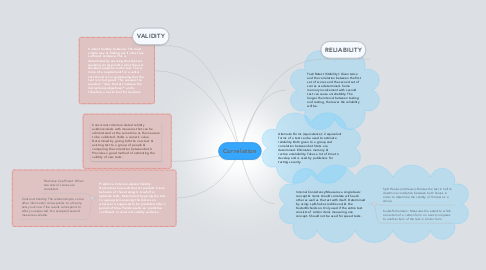Correlation
by Daphne Townzen

1. Content Validity Evidence: The most simple way of finding out if a test has sufficient evidence. This is determined by ensuring that the test questing correspond to what the user decides should be on the test. This is more of a requirement for a useful test than it is for guranteeing that the test is in fact good. This answers the question "does the test measure the instructional objectives?" and is therefore a crucial tool for teachers.
2. VALIDITY
3. Concurrent criterion-related validity evidence:deals with measures that can be administered at the same time as the measure to be validated. Yeilds a numeric value. Determined by giving bith the new test & existing test to a group of people & comparing the correlation between both. Provides a good method of estimating the validity of new tests.
4. Predictive Criterion-related Validity: Determines how well the test predicts future behavior of those taking it. Useful for aptitude tests. Determined by giving the test to a group & measuring the testers on whatever is supposed to be predicted after a period of time. Yields results as: predictive coefficient or construct validity evidence.
4.1. Predictive Coefficient: When two sets of scores are correlated
4.2. Construct Validity: The relationship to some other information corresponds to a theory. Lets you know if the results correspond to what you expected. No accepted second measure available.
5. RELIABILITY
6. Test/Retest (Stability): Given twice and the correlation between the first set of scores and the second set of scores are determined. Some memory involvement with second test can cause unreliability. The longer the interval between testing and resting, the lower the reliability will be.
7. Alternate Forms (equivalence): 2 equivelant forms of a test can be used to estimate reliability. Both given to a group and correlation between both tets are determined. Eliminates memory & ractice unreliability. Takes a lot of time to develop and is used by publishers for testing security.
8. Internal Consistency:Measures a single basic concept & items should correlate with each other as well as the test with itself. Determined by using: split-halves (odd/even) & the Kuder-Richardson. Only used if the entire test consists of similar items measuring one concept. Should not be used for speed tests.
8.1. Split Halves (odd/even):Divides the test in half to determine correlation between both halves in order to determine the validity of the test as a whole.
8.2. Kuder-Richardson: Measures the extent to which oone item of a certain form on a test compares to another item of the test in similar form.


